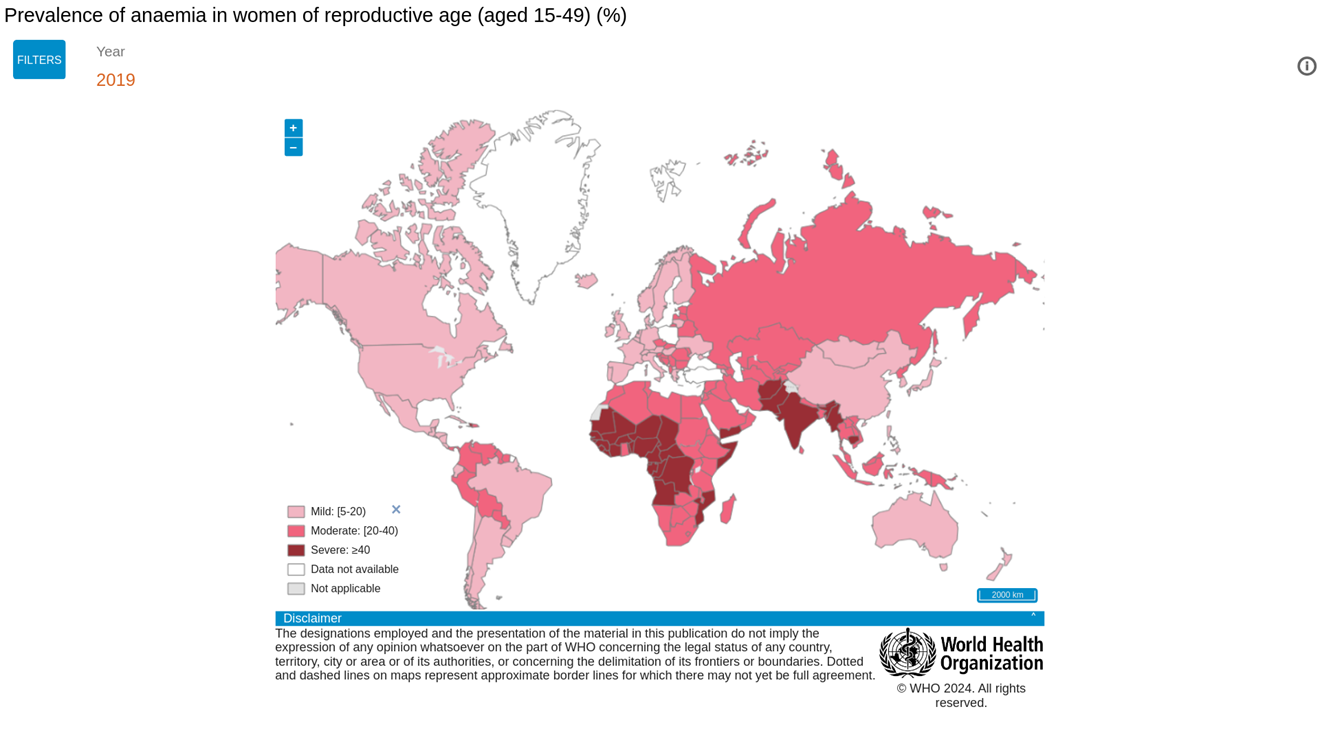Anaemia: an indicator of health and well-being
Anaemia is a condition in which the number of red blood cells or the haemoglobin concentration is lower than normal. The effects can include fatigue, poor cognitive and motor development in children, poor birth outcomes, and increased morbidity and mortality. Whether moderate or severe, anaemia can also worsen the effects of other illnesses.

Anaemia is a global health problem affecting billions
Anaemia is a persistent global public health concern. Nearly one in four people around the world is affected by it. Most of them are women and children living in low resource settings. Anaemia disproportionately affects young children, pregnant and postpartum women, and menstruating adolescent girls. It is estimated that 40% of all children aged 6–59 months, 37% of pregnant women and 30% of women 15–49 years of age are living with anaemia. Overall, it affects twice as many women as men, highlighting important gender inequalities. While the causes and risk factors of anaemia are diverse, tackling it is possible through strong leadership and cross-sector collaboration.
Global goals and targets for reducing anaemia
In 2012, the World Health Assembly (WHA) called for a 50% reduction in anaemia among women of reproductive age by 2025, and in 2019 the prevalence of anaemia among women was added as an indicator for SDG Target 2.2 on Ending all forms of malnutrition. Achieving this target would improve the lives of millions of women and children through better health and well-being and contribute to a more productive economy.
However, progress towards global targets has been slow. Unfortunately, anaemia prevalence has stagnated, and the world is not on track to achieve these targets. Therefore, there is an urgent need for immediate action on anaemia. A synergistic approach within health and across sectors will be instrumental in making effective progress.
Consequences of anaemia
Health
- Increased risk of infections and death
- Increased risk of miscarriages, stillbirths, prematurity and low birth weight
- Extreme fatigue and lethargy
Development
- Lower cognition
- Poorer growth and development
Economic
- Impaired physical productivity and work performance
- Loss of earnings
Symptoms of anaemia
Children and pregnant women face greater vulnerability to anaemia, with more severe cases increasing the risk of maternal and child death. Iron deficiency anaemia has also been shown to affect cognitive and physical development in children and reduces adult productivity.
Tiredness
Dizziness when standing up
Cold hands and feet
Shortness of breath, especially upon exertion
Bruising more easily
Causes and risk factors of anaemia
Anaemia is diagnosed based on blood haemoglobin concentrations falling below specified thresholds established depending on age, sex, and physiological status. It is considered a symptom of an underlying condition(s). Anaemia can be caused by several factors, the most common are:
Nutrient deficiencies (caused by inadequate diet or inadequate absorption of nutrients)
Infections (e.g. malaria, parasitic infections, tuberculosis, HIV), inflammation and chronic diseases
Gynaecological and obstetric conditions
Inherited red blood cell disorders
Understanding the direct causes of anaemia and their implications for health
Nutrient deficiencies
Primarily due to inadequate dietary iron intake, is considered the most common nutritional deficiency leading to anaemia. Deficiencies in vitamin A, folate, vitamin B12, and riboflavin can also contribute to anaemia due to their roles in haemoglobin synthesis or red blood cell production.
Additional mechanisms include:
- nutrient losses: including blood loss from parasitic infections, haemorrhage associated with childbirth, or menstrual loss
- impaired absorption: some conditions can affect how the body absorbs iron
- low iron stores at birth: can put infants at risk for iron deficiency anaemia
- nutrient interactions: certain nutrients can compete for absorption and reduce bioavailability
Deficiencies in vitamin A, folate, vitamin B12 and riboflavin can also result in anaemia due to their specific roles in the synthesis of haemoglobin and/or erythrocyte production.
Infectious diseases, chronic conditions and inflammation
Depending on the local burden of infectious diseases, such as malaria, tuberculosis, HIV and parasitic infections.
These infections can:
- impair nutrient absorption and metabolism (e.g. malaria, ascariasis)
- cause blood loss (e.g. schistosomiasis, hookworm infection).
Chronic conditions can cause inflammation, leading to anaemia of inflammation or anaemia of chronic disease. Infections can cause anaemia through various other mechanisms, including:
- ineffective red blood cell production
- excessive red blood cell destruction
- blood loss
- side effects of drug treatment
Gynaecological and obstetric conditions
Gynaecological and obstetric conditions can increase the risk of anaemia, including:
- consistent heavy menstrual losses
- maternal blood volume expansion during pregnancy
- blood loss during and after childbirth, particularly in cases of postpartum hemorrhage.
Inherited red blood cell disorders
Inherited red blood cell disorders are also a common cause of anaemia in some regions. These include:
- Thalassemia (alpha and beta): Abnormalities in hemoglobin synthesis.
- Sickle cell disorders: Changes in hemoglobin structure.
- Other hemoglobinopathies: due to haemoglobin gene variants
- abnormalities of red cell enzymes
- abnormalities of the red blood cell membrane.
Prevention and treatment of anaemia
Effective treatment and prevention of anaemia depends on the underlying cause of the condition. There are many effective ways to treat and prevent anaemia. Changes in diet can help reduce anaemia in some cases, including:
- consuming foods rich in iron, folate, vitamin B12, vitamin A, and other nutrients
- eating a healthy diet with a variety of foods
- taking supplements if recommended by a qualified health-care provider.
Other health conditions can cause anaemia. Here are some preventive and treatment actions:
- prevent and treat malaria, schistosomiasis and other infections caused by soil-transmitted helminths (parasitic worms)
- get vaccinated and practice good hygiene to prevent infections
- manage chronic diseases like obesity and digestive problems
- space pregnancies by at least 24 months and use birth control to prevent unintended pregnancies.
- prevent and treat heavy menstrual bleeding and haemorrhage before or after birth
- delay umbilical cord clamping after childbirth (not earlier than 1 minute)
- treat inherited red blood cell disorders like sickle-cell disease and thalassemia.

Anaemia is a strong indicator of overall health and well-being. Understanding its implications is crucial for effective treatment and prevention

